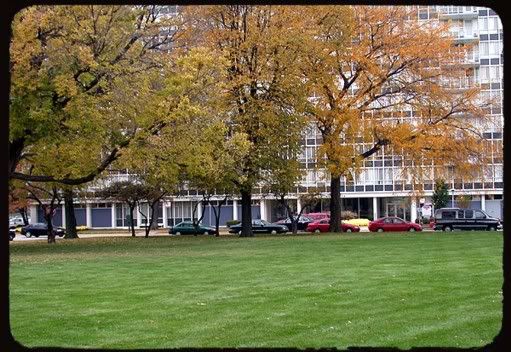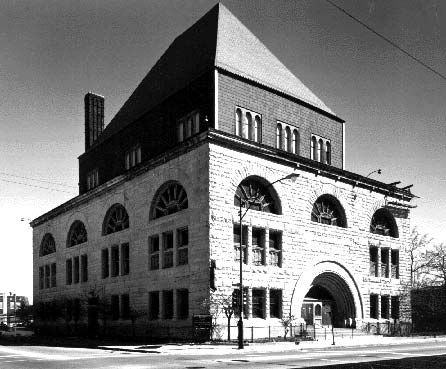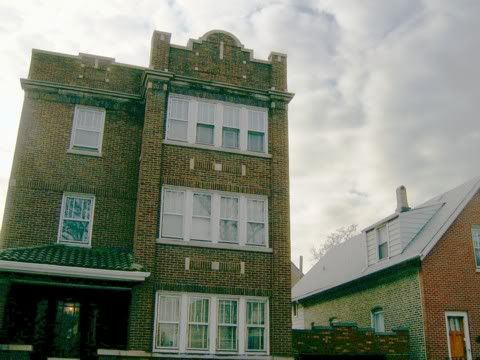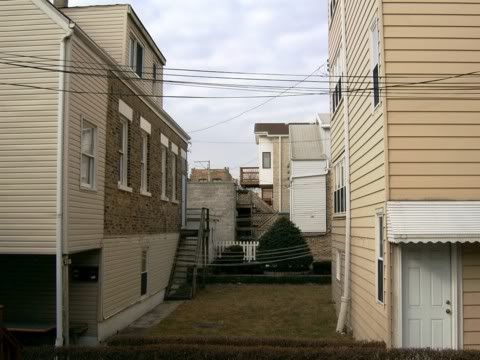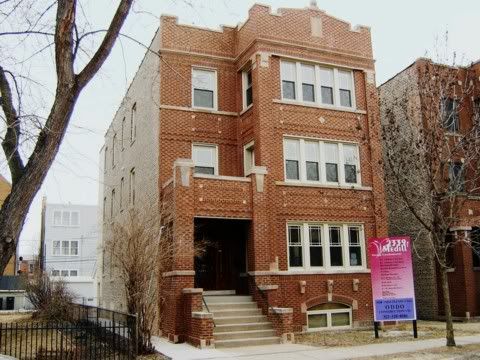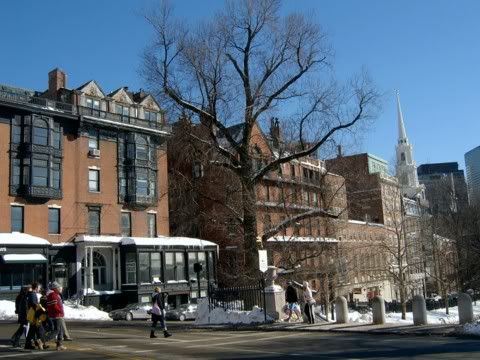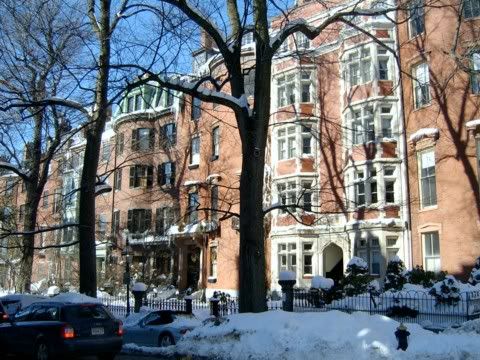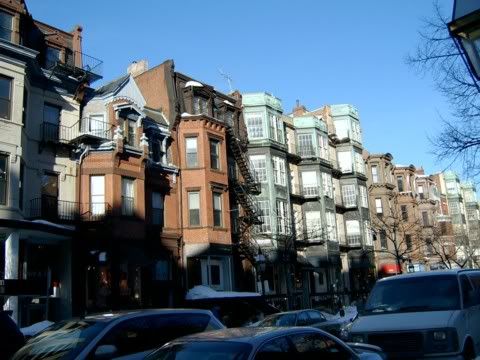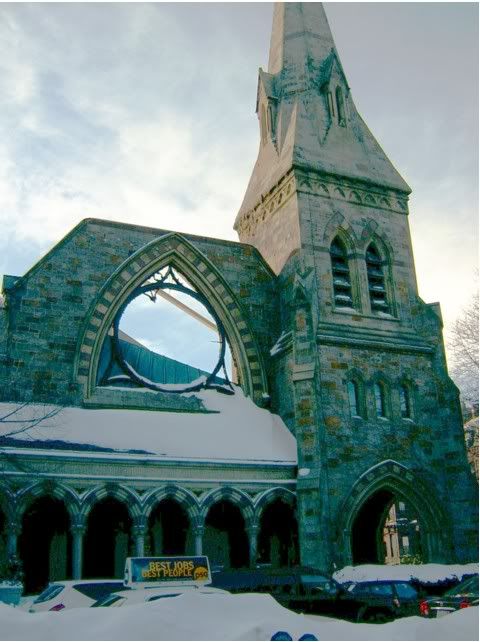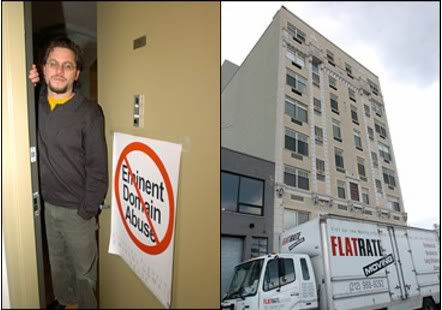
More on Eminent Domain abuse from today's New York Times:
DAN GOLDSTEIN loves his new home, a 1,280-square-foot, two-bedroom, two-bath, roughly finished condominium in a former warehouse building on Pacific Street near downtown Brooklyn. Which is why he does not want to leave, even though he is being pressed to do so.
The approach to the building is not the grandest. Across the street are the dormant subway cars of the Atlantic Avenue rail yards, loosely corralled by a chain-link fence. Beyond the yards lie the dubious aesthetic pleasures of the Atlantic Mall.
But the former warehouse - the Allied Storage Building, designed by the architect George S. Kingsley and built in 1926 - with its blue and white ceramic medallions and florid stone rosettes, presents a noble face (and a singular one) that harks back to a time when even a building made for storage hoped to be beautiful. Besides, Mr. Goldstein's apartment, on the seventh floor, faces Dean Street and Flatbush Avenue, and its views of Brooklyn are glorious.
Mr. Goldstein is the only resident of the condo, now called the Atlantic Art Building, who has not sold his or her apartment to Bruce C. Ratner and his Forest City Ratner company in the last year to make way for a development that is to include a new home for Mr. Ratner's New Jersey Nets.
I've taken some time off the last couple days to start reading The Power Broker: Robert Moses and the Fall of New York, the excellent biography of Robert Moses that Wells gave me. The book helped destroy his reputation, but since I've only heard the bad stuff before it's actually made me more sympathetic. I want to hate the guy (he's known as a builder of superhighways and horrible modernist housing projects), but really I find him fascinating. He definitely had an idealistic side, and his later obsession with organizing power to transform the world is scary, but something I totally understand. He was an early force behind civil service reform, reforming prisons to rehabilitate rather than just punish, creating the state park system - and all this by the time he was my age. His habit of looking out the window of a car or train and obsessively building stuff in his head is one that I share.
No name is as closely associated with eminant domain as Robert Moses. The guy demolished whole neighborhoods to make New York accessible by automobile (and by any reasonable standard he failed). He's also (mostly wrongly) often blamed for causing sprawl and massive white flight to the suburbs (racism and misguided federal policies had a lot more to do with it).
Atlantic Art was the name given to the 31-unit building by its developer, Marc Freud, who briefly tried to brand its neighborhood NoFA, for, north of Flatbush Avenue, when he converted the building in 2002. It now sits in the middle of a development planned by Mr. Ratner, Forest City Ratner's president. In addition to the new home for his basketball team, Mr. Ratner hopes to put up office and apartment towers designed by Frank Gehry. Company officials say they are poised to sign a memo of understanding with the city in a few weeks.
The 21-acre footprint for the controversial plan, which the company estimates would raze about 140 apartments, stretches from Atlantic Avenue to Dean Street and from Flatbush to Vanderbilt Avenues. It would erase the area's most recent incarnation as a yuppies-on-the-edge outpost of Prospect Heights, one organized by developers like Shaya Boymelgreen, whose conversion of the former Daily News printing plant at 700 Pacific Street into condominiums spurred hasty copycat conversions of other industrial buildings, including Allied Storage.
(That incarnation, of course, rests on the shoulders of more grass-roots conversions made by artist pioneers, who colonized the largely industrial area 15 or so years ago.)
While he's rightly criticized for riding roughshod over the rights of property owners, destroying once-great neighborhoods and creating ugliness on a monumental scale, at least Moses was seizing property to build public roads, parks and housing. Today's eminent domain battles seem to be all about benefitting private organizations (such as the Jets or the, er, Brooklyn Nets) or well-connected developsers. Moses was at least part of the movement to make government accountable and use it to wrest control from the plutocrats who controlled the country in his Guilded Age youth - in the decades since his death power seems to have shifted back into the hands of big corporations and the wealthy to an extent not seen since before the Depression. It almost makes me miss a bastard who would seize land from the private estates of guys with names like Vanderbilt, Wintrhop and Whitney to build a park.
"I'm a person living in the home I love," he said, "and I intend to stay in it. I haven't had any construction problems. Anyway, I may be the only one in my building opposed to the Ratner plan, but there are thousands living within and without the footprint who are against it."
Indeed, as members of Develop Don't Destroy Brooklyn, Mr. Goldstein and others have collected 12,000 signatures opposing the project. The group, which has the support of many community leaders, offers as an alternative a more organic, home-grown development, the Unity Plan, that calls for keeping, not razing, the existing buildings, and for new construction on the rail yards.
The week before last, Mr. Goldstein's front door was decorated with a red and white poster with the slash-in-a-circle graphic surrounding the words "Eminent Domain Abuse"; a sisal Peter Max "Love" doormat sat below. An old desk topped with a hamper and some glass vases sat outside a neighbor's door, the discards from the neighbor's exodus.
Inside, Mr. Goldstein's apartment was both folksy and industrial, with smoke-colored walls and wood and resin furniture made by his friend Sebastian Hamilton. Jane Jacobs's manifesto on new urbanism, "The Death and Life of Great American Cities," lay on a coffee table.
. . .
When he read about Mr. Ratner's plan to move the Nets near the mall on Atlantic Avenue, Mr. Goldstein said, he thought, "Well, that's nice, I like sports."
"I didn't think an arena would be built on top of a residential neighborhood," he added.

